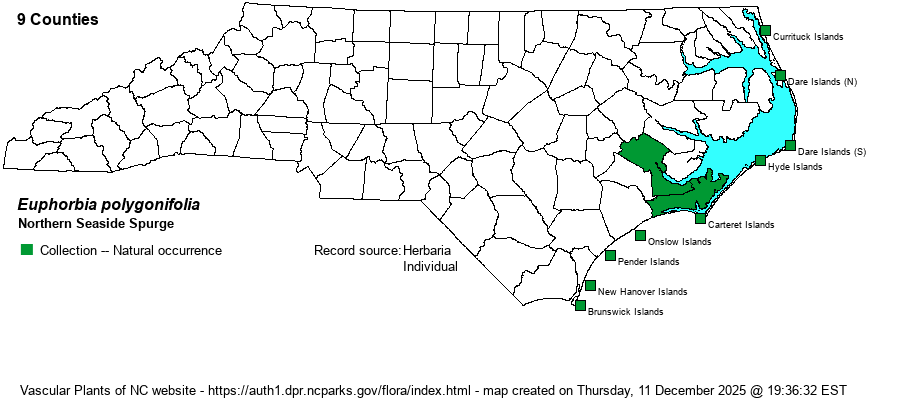| Author | L. | |
| Distribution | Outer Banks, barrier islands; occasionally along shores of sounds on the mainland.
Maritime -- N.S. to northeastern FL; disjunct to Great Lakes. | |
| Abundance | Generally common and easily found in dune habitats. Much more common than the scarce E. bombensis, which grows in nearly identical habitats. The NCNHP State Rank of S3 is quite conservative; it is a common coastal plant, deserving of an S4 rank. | |
| Habitat | Upper portion of ocean beaches, wrack lines, semi-stable dunes, stable dune barrens, sandy interdune swales, washover fans. E. bombensis grows in similar habitats, but seldom on the foreside of dunes; it is most often in more sheltered sands, such as in flats behind dunes. |
| Phenology | Flowering and fruiting May-October. | |
| Identification | Northern Seaside Spurge is a prostrate mat-former with glabrous stems and inflorescences (vs. pubescent in E. maculata). It often grows with E. bombensis, and can be told this latter species by larger seeds (2.2-2.6 mm long vs. 1.5-1.9 mm) and having only terminal inflorescences (vs. axillary and terminal). Northern Seaside Spurge has noticeably longer and more tapered elliptical leaves than does the other, which has leaves rather rectangular and truncated at the tip; its leaves are lighter to medium green as opposed to often dark green in E. bombensis. Heartleaf Sandmat (E. cordifolia) also is glabrous, but it occurs only inland and has tiny rounded leaves. Northern Seaside Spurge is one of the more easily found forbs of coastal dunes and sand flats, with the reddish stems, numerous long and somewhat oblong leaves, and flower clusters only at the branch tips being quite obvious. | |
| Taxonomic Comments | None
| |
| Other Common Name(s) | Northern Sandmat; Seaside Spurge and Seaside Sandmat are too generic, as the very similar E. bombensis is not excluded with these names -- a modifier name is required for E. polygonifolia (typically Northern is used). | |
| State Rank | S3 [S4] | |
| Global Rank | G5? | |
| State Status | | |
| US Status | | |
| USACE-agcp | FACU link |
| USACE-emp | FACU link |

